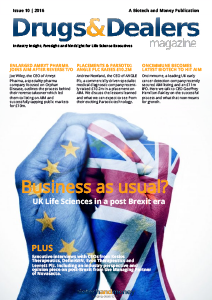Here, we examine…
- the variety of options available to fledgling biotechs
- the pros and cons of each route
- the influence of large pharmas and biotechs collaborating at an early stage
- the rise of charitable foundations and venture philanthropy
- how NYC can use these routes to fuel its up-and-coming biotech scene
First off, it’s worth probing why traditional venture capitalists are running a mile from such a seemingly buzzing sector. Surely there are profits to be gained from exciting new life-saving therapeutics?
Well yes, but at a cost: the high risk which accompanies investing in the sector is not a price that anyone wants to pay right now.
Pre-2008 financial crisis, pension funds, hedge funds and many others all had significant stakes in higher risk ventures through VCs, helping to fuel a generation of brave new entrepreneurs. But the bubble burst, and banks were criticised for taking so much risk with their customers’ money. What’s more, many funds found that the returns they had been seeing from investment in biotech through VCs was actually not high enough to validate the risk involved anyway. High risk went out of fashion overnight.
Perhaps not enough of these ventures turned out to be fruitful; perhaps too many duds were given funding and allowed to fail. Whatever the reasons for the sudden crash, the results are clear: a lack of trust in high-risk biotech investment through VCs and a preference towards more traditional investments with less potential for disaster.
Bad news for start-ups with heaps of potential. So what other options do they have?
Angel investors
Many young entrepreneurs may attempt to self-fund, or turn to family and friends for springboard capital. Angel investors are the next step up from this. Turning to a high net worth individual for capital doesn’t just bring a monetary benefit, but also access to contacts, expertise and mentoring. Most angel investors will have been through the hoops themselves and will be able to offer advice on turning academic vigour into a thriving company.
New York Angels, based in south west Manhattan, has invested $50 million in over sixty start-ups since 2003, and features many high profile tech entrepreneurs among its investors (Scott Kurnit, About.com; Linda Holliday, Digitas Health). Meanwhile, Golden Seeds – based in New York, Boston and San Francisco, focuses on female entrepreneurs with an aim to improve gender equality in business.
Corporate Venture Capital
When VCs don’t want to invest in start-ups, the responsibility often falls into the venture arms of large firms, who are looking to raise their competitive advantage by having stakes in the next generation of talent. With their higher tolerance for risk, high levels of subject expertise and on-tap management skills, CVCs are an attractive target for small companies. The major disadvantage, of course, is the need to function on the terms of the parent company: a young entrepreneur’s vision of IPO may not sit so well with a big pharma’s more realistic vision of M&A or a quick exit.
Pfizer Ventures has offices in the heart of Manhattan, and several other large pharmaceuticals also have stakes in NYC’s life sciences scene. You can read about them all here.
Government Grants
Whilst one might associate government grants with academia more than business, government grants – both local and national – are an important source of start-up revenue for many small companies. On a national level, the US National Institutes of Health had invested $10 billion in clinical R&D being undertaken by small companies by the end of 2012, whilst on a more local level, Massachusetts and California possess governmental funds for biotech start-ups worth $1 billion and $1.8 billion respectively – California’s being set aside specifically for stem cell and regenerative medicine research.
The New York City Economic Development Corp. (NYCEDC)’s early stage life sciences funding initiative, whilst smaller in scale ($150 million), has similar goals in mind. Invested in by several big pharma VC firms, this fund nicely showcases the paradigm shift in NYc’s life sciences scene from private equity to a more collaborative model.
Foundations
Venture Philanthropy is a useful stop-gap for when other sources of revenue don’t present themselves. It is particularly useful for the highest risk ventures, as these foundations aren’t motivated by a return on their clients’ investments, but by the desire to advance treatments for some of the most world’s most problematic diseases.
A poll by Life Sciences Network – a blog specialising in life science data acquisition – found that research into neurodegenerative diseases (such as Alzheimer’s disease, ALS or Parkinson’s) usually get the most funding, due to their high risk nature – which is compounded by a lack of suitable animal models on which to study potential treatments. The Alzheimer’s Drug Discovery Foundation and the Michael J. Fox Foundation for Parkinson’s Research are examples of organizations motivated by the promise of a cure to a specific disease.
Other high risk areas favoured by these foundations include oncology (e.g. The Leukemia & Lynphoma Society), and research into diseases such as malaria and AIDS (e.g. The Bill and Melinda Gates Foundation).
Family Offices
Like a cross between angel investors and charitable foundations, many high net worth (usually > $100 million) families set up funds to target specific unmet medical needs. These funds – often in the region of several millions of dollars – are either managed along with similar familial funds in a Multiple Family Office (MFO), or in the case of the exceptionally wealthy, in a standalone Single Family Office (SFO).
Whilst investment and returns are usually the main aims of these funds, there is still a charitable element to many of them, as well known families look to either promote their reputation or make an impact on a disease that is close to their hearts. Having said this, family institutions don’t like to be bugged 24/7, so tend to keep below the radar as much as possible. A start-up’s best bet in attaining this kind of funding is an introduction through a trusted associate or network.
Here we have looked a little into the wide variety of alternative funding options available to new biotech talent for when traditional VC isn’t an option. If New York is to address the issues caused by its relative lack of VCs, it must exploit these other routes as best it can. NYCEDC’s early stage initiative is a good start, but in order to seriously attract young biotech companies to the city – as well as stopping its own innovation from moving elsewhere – this government fund must grow and develop via investment from the US’s many foundations and high net worths.
On the 17th of November 2015, Biotech and Money will host its prestigious New York conference.
Attracting some of the biggest names in life sciences, pharma and investment, the Biotech and Money New York event promises to be a unique opportunity to gain a fresh perspective on the life sciences scene in one of the US’s fastest growing biotech hubs.
Confirmed speakers include Jit Patel, Vice President of Research Business Development at JDRF; Howard Fillit, Founding Executive Director and Chief Science Officer of the Alzheimers Drug Discovery Foundation; Sohini Chowdhury, Senior Vice President of Research Partnerships at The Michael J. Fox Foundation for Parkinson's Research; and Charlotte Hubbert, Program Investment Officer for Venture Investing at the Bill & Melinda Gates Foundation.
















Add Your Response